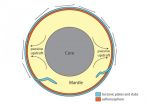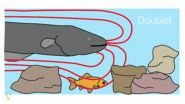Geophysicists challenge traditional theory underlying the origin of mid-plate volcanoes
Source of volcanoes may be much closer than scientists thought
2014-12-04
(Press-News.org) A long-held assumption about the Earth is discussed in today's edition of Science, as Don L. Anderson, an emeritus professor with the Seismological Laboratory of the California Institute of Technology, and Scott King, a professor of geophysics in the College of Science at Virginia Tech, look at how a layer beneath the Earth's crust may be responsible for volcanic eruptions.
The discovery challenges conventional thought that volcanoes are caused when plates that make up the planet's crust shift and release heat.
Instead of coming from deep within the interior of the planet, the responsibility is closer to the surface, about 80 kilometers to 200 kilometers deep -- a layer above the Earth's mantle, known as the as the asthenosphere.
"For nearly 40 years there has been a debate over a theory that volcanic island chains, such as Hawaii, have been formed by the interaction between plates at the surface and plumes of hot material that rise from the core-mantle boundary nearly 1,800 miles below the Earth's surface," King said. "Our paper shows that a hot layer beneath the plates may explain the origin of mid-plate volcanoes without resorting to deep conduits from halfway to the center of the Earth."
Traditionally, the asthenosphere has been viewed as a passive structure that separates the moving tectonic plates from the mantle.
As tectonic plates move several inches every year, the boundaries between the plates spawn most of the planet's volcanoes and earthquakes.
"As the Earth cools, the tectonic plates sink and displace warmer material deep within the interior of the Earth," explained King. "This material rises as two broad, passive updrafts that seismologists have long recognized in their imaging of the interior of the Earth."
The work of Anderson and King, however, shows that the hot, weak region beneath the plates acts as a lubricating layer, preventing the plates from dragging the material below along with them as they move.
The researchers show this lubricating layer is also the hottest part of the mantle, so there is no need for heat to be carried up to explain mid-plate volcanoes.
"We're taking the position that plate tectonics and mid-plate volcanoes are the natural results of processes in the plates and the layer beneath them," King said.
INFORMATION:
[Attachments] See images for this press release:

ELSE PRESS RELEASES FROM THIS DATE:
2014-12-04
VIDEO:
Vanderbilt biologist Kenneth Catania describes his discovery that the electroshock system used by the electric eel to detect and immobilize prey is uncannily similar to the Taser.
Click here for more information.
The electric eel - the scaleless Amazonian fish that can deliver an electrical jolt strong enough to knock down a full-grown horse - possesses an electroshock system uncannily similar to a Taser.
That is the conclusion of a nine-month study of the way in which ...
2014-12-04
The "survival of the fittest" principle applies to cells in a tissue - rapidly growing and dividing cells are the fit ones. A relatively less fit cell, even if healthy and viable, will be eliminated by its more fit neighbors. Importantly, this selection mechanism is only activated when cells with varying levels of fitness are present in the same tissue. If a tissue only consists of less fit cells, then no so-called cell competition occurs. Molecular biologists from the University of Zurich and Columbia University are the first researchers to demonstrate in a study published ...
2014-12-04
Since 2010, detections of Asian Carp environmental DNA or "eDNA" have warned scientists, policymakers, and the public that these high-flying invaders are knocking on the Great Lakes' door. Scientists capture tiny DNA-containing bits from water and use genetic analysis to determine if any Asian Carp DNA is present. New research published by Notre Dame scientists shows that the tools currently used for Asian Carp eDNA monitoring often fail to detect the fish. By comparison, the new eDNA methods described in this study capture and detect Asian Carp eDNA more effectively.
The ...
2014-12-04
ITHACA, N.Y. - Among the billions and billions of stars in the sky, where should astronomers look for infant Earths where life might develop? New research from Cornell University's Institute for Pale Blue Dots shows where - and when - infant Earths are most likely to be found. The paper by research associate Ramses M. Ramirez and director Lisa Kaltenegger, "The Habitable Zones of Pre-Main-Sequence Stars" will be published in the Jan. 1, 2015, issue of Astrophysical Journal Letters.
Images and study: https://cornell.box.com/infantearths
"The search for new, habitable ...
2014-12-04
For nearly 40 years, one of the cornerstones of the study of adaptation has been the examination of "whole-organism performance capacities"--essentially, measures of the dynamic things animals do: how fast they can run; how hard they can bite; how far, fast, and high they can jump; and so on. Together, these functional attributes determine the performance of a species' ecology: the types of food one can eat; the ability to capture or locate prey; the ability to avoid predation; the ability of males to intimidate or, in some cases, prevent rival males from invading a territory; ...
2014-12-04
Insects can transmit viral diseases to humans. Therefore, understanding how insects cope with viral infection, and what immune mechanisms are triggered, can be important to stop diseases transmission. In a study published in this week's issue of the scientific journal PLOS Pathogens*, researchers from the Instituto Gulbenkian de Ciencia (IGC; Portugal) now show that the entry route of the virus changes how the insect host responds to it. Using the fruit flies as a model of study, they discovered an immune mechanism that is specifically effective when flies are infected ...
2014-12-04
BOULDER - New research demonstrates for the first time that an increase in greenhouse gas concentrations thousands of years ago was a key factor in causing substantially more rainfall in two major regions of Africa. The finding provides new evidence that the current increase in greenhouse gases will have an important impact on Africa's future climate.
The study, led by the National Center for Atmospheric Research (NCAR), is being published this week in Science.
"The future impact of greenhouse gases on rainfall in Africa is a critical socioeconomic issue," said NCAR ...
2014-12-04
WASHINGTON - Children in emergency departments can safely be treated for pain from limb injuries using intranasal ketamine, a drug more typically used for sedation, according to the results of the first randomized, controlled trial comparing intranasal analgesics in children in the emergency department. The study was published online last month in Annals of Emergency Medicine ("The PICHFORK (Pain in Children Fentanyl OR Ketamine) Trial: A Randomized Controlled Trial Comparing Intranasal Ketamine and Fentanyl for the Relief of Moderate to Severe Pain in Children with Limb ...
2014-12-04
BUFFALO, N.Y. -- Micheal L. Dent, a University at Buffalo psychologist, listens to what is inaudible to others. And what she's hearing might one day help us better understand human hearing loss.
Dent studies ultrasonic vocalizations (USVs) in mice. These sounds are above the human ear's upper limit, but they can be recorded and played back using specialized equipment that has allowed Dent to capture an impressive repertoire that when graphically represented shows a variety of sweeps, arcs, dips and curves. The tempo and intensity of these vocalizations change, as does ...
2014-12-04
TORONTO, Dec. 4, 2014 - Results from an ongoing survey conducted by the Centre for Addiction and Mental Health (CAMH) show that 2.2 per cent of adults --or over 230,000 people in Ontario, Canada -- seriously contemplated suicide in the last year. The 2013 edition of the CAMH Monitor, released today, included questions about suicidal ideation for the first time in the survey's history.
"Suicide is a major public health issue, and these data confirm that large numbers of Ontario adults report having suicidal thoughts," said Dr. Hayley Hamilton, CAMH scientist and co-principal ...
LAST 30 PRESS RELEASES:
[Press-News.org] Geophysicists challenge traditional theory underlying the origin of mid-plate volcanoes
Source of volcanoes may be much closer than scientists thought



